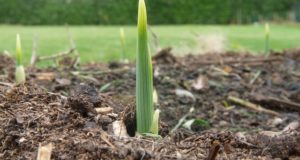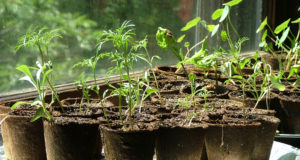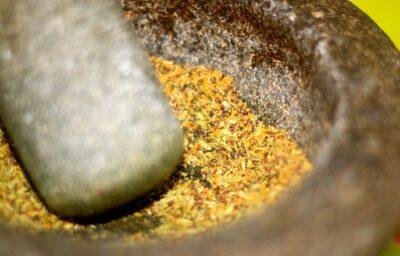
Image source: catherinejonescooks.com
Read part 1 in this series here.
It’s certainly true that when it comes to growing herbs and spices, herbs get most of the attention. While pretty much everyone can grow herbs here in the US, only those in warmer zones can grow some of the true spices. But there are spices or seasonings anyone can make — like onion powder.
Spices are often more challenging to grow and preserve compared to herbs, but the end result is well worth the extra effort. As a bonus, many of these spices perform double-duty as an herb or vegetable.
Easy-to-Grow Spices
The following spices tend to be easier to grow and preserve:
1. Ginger, Onion and Garlic. These three are all lumped together under spices, since you can preserve the roots and grind them to make powders. Ginger, onion and garlic powders are all very common seasonings and will be well-used in your kitchen. You can find numerous varieties of garlic and onion to grow in pretty much every zone in the US. Ginger does prefer warmer weather, so unless you are in zones 9-12, you won’t be able to grow it outdoors as a perennial. Many people have success growing it indoors in pots or overwintering it in pots, however. Since there are so many varieties of these plants, follow the directions given on the seeds you buy.
2. Paprika. This beautiful red spice is common in Hungarian and Spanish cuisine but is quite popular all over the world. Paprika comes from the paprika pepper and is fairly easy to grow like most peppers. It will grow best in a high-quality, well-drained soil and will grow very well in all but the coldest climates. Start your seeds indoors if you are in zone 5 or lower, but if in zones 6 and up you often can plant seeds directly into the garden after the danger of frost has passed.
3. Cumin. Cumin might seem like a spice only grown in a far-off land, but if you live in zones 5 to 10 you should be able to grow this for yourself. Cumin is actually in the parsley family and not too difficult to rear.
The Best Source For Heirloom Seeds Is Right Here!
However, this spice does require quite a long growing season, so you must start your seeds indoors a minimum of 4 weeks before the last frost (grow time is about 120 days). Though the seeds are what is used to make the spice, the leaves of this plant are also edible.
 4. Coriander. If you aren’t already familiar with coriander you may not know that coriander and cilantro are one in the same plant. The plant is referred to as cilantro when it is young and the leaves are gathered as an herb. After maturity and the plant flowers, it is then considered coriander. Coriander as a spice refers to the seeds gather from the flower heads of this plant. You can buy cilantro plants and raise them for coriander or buy coriander plants. Follow the same directions for growing coriander as you do with cilantro. Just let the plant develop flower heads rather than harvest it back.
4. Coriander. If you aren’t already familiar with coriander you may not know that coriander and cilantro are one in the same plant. The plant is referred to as cilantro when it is young and the leaves are gathered as an herb. After maturity and the plant flowers, it is then considered coriander. Coriander as a spice refers to the seeds gather from the flower heads of this plant. You can buy cilantro plants and raise them for coriander or buy coriander plants. Follow the same directions for growing coriander as you do with cilantro. Just let the plant develop flower heads rather than harvest it back.
5. Chili. You can use chili peppers as a spice or seasoning in two ways: grind up the dried peppers as a powder or use your dried peppers to make a chili paste. There are a ton of variety of peppers available through most seed catalogs. Follow recommendations for growing based on the pepper varieties you chose. Generally, peppers grow best in a well-drained, rich soil and in full sun. They do best in warm weather, although very warm temps around 98 degrees Fahrenheit can lead to issues with dropped flowers.
6. Mustard Seed. You can get both mustard seeds and mustard greens from this versatile plant. The mustard plant is really easy to grow and quite prolific in terms of harvest. Start your seeds indoors if you live in a cooler climate. It takes about two months to start harvesting mustard greens. Leave the plant alone so it will bolt (warm weather will hurry the process).
The care of most spices is really no different than the care outlined for herbs in part 1 of this guide.
Learning when to harvest your herbs and spices is extremely important. Each plant has a specific time when it’s at its optimal maturity for harvesting. Harvest too young or too old and you’ll lose flavor or in the case of some spices, the seeds will end up on the ground.
Harvesting Herbs
Herbs are pretty easy to harvest and all it takes is some practice to be able to look at your plants and determine what to pluck and where. As mentioned in part 1 of this guide, make sure you stay on top of removing any flower heads from your leafy herbs. You also only want to pluck leaves from the top and middle of the plant, leaving the large bottom leaves alone. Additionally, always harvest in the early morning rather than during the heat of the day.
New “Survival Herb Bank” Gives You Access to God’s Amazing Medicine Chest
Here are the specifics on harvesting each of the 10 herbs.
- Basil, Oregano and Thyme. Harvest leaves or whole sprigs regularly once they start growing. Be careful to not over-pluck your plant, but take leaves weekly. Harvest the whole plant before first frost, as the cold will ruin the leaves and flavor.
- Rosemary. Rosemary can be harvested at any time once the plant matures. You will cut whole sprigs rather than the individual leaves.
- Cilantro. Harvest the large leaves regularly from this plant to keep it low. If you are growing cilantro for their seeds (coriander) as well, you may want different plants for cilantro and coriander.
- Mint. Either pick leaves as you need them or cut back the entire plant about two inches from the ground. Mint is a voracious grower and you can often get two, three or even four big harvests from each plant.
- Parsley. Parsley is particular about its harvest period. Wait until your plant has stems with three segments to ensure the plant is mature enough. Secondly, only harvest leaves from the outside of the plant, never the inside.
- Sage. Sage differs from the other herbs on this list as it will give you a better harvest the second year. Be careful to not overharvest the first year as it will damage the plant. You can take whole stalks or a couple of leaves depending on your needs. Be sure to always leave a few stalks behind to ensure your sage plant will continue producing.
- Chives. Chives are a super-prolific herb and can be harvested upwards of four-plus times in just its first year. Similarly to mint, harvesting chives involves cutting the whole plant down to two inches above the soil.
- Lemongrass. Lemongrass can be harvested during any time once the plant has matured, but it is best to wait until late in your growing season to get the best tasty lemongrass possible. Harvest stalks by pulling the whole stalk or cutting right above soil level.
Harvesting Spices
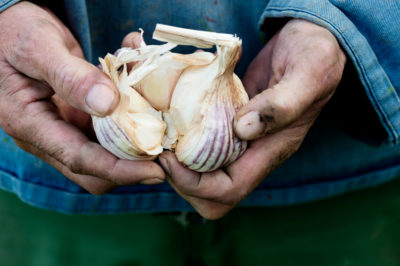 Harvesting spices really isn’t difficult and in some aspects is easier than harvesting herbs. Here is a quick rundown of how to harvest the eight spices mentioned in this guide.
Harvesting spices really isn’t difficult and in some aspects is easier than harvesting herbs. Here is a quick rundown of how to harvest the eight spices mentioned in this guide.
- Ginger. First off, you don’t need to harvest all your ginger in one session. It is best to wait until each individual plant is ready and you’re ready to use it (if using fresh). The easiest way to tell if these roots are ready to be harvested is by the size of the stalks. Very thick stalks mean you will have a thick rhizome. The easiest way to harvest your ginger is by getting your hands right into the soil to dig up the roots. This is easier than using a tool and ensures you don’t accidently gouge a nearby root.
- Onion. Harvesting onion is a two-part process. As your plants mature you will notice that the stalks turn yellow and begin to droop. At this point you want to cut off the stalks or use a hoe to stomp the stalks down. Use your hands to fluff up the soil around the onions and then leave the onions in the dirt for a couple of days. After two or three days, again use your hands (no tools or you may bruise the onions) to bring the onions up to the surface to dry. Once the onion tops turn brown, they are ready to be stored.
- Garlic. Harvesting garlic is quite similar to onion. Wait until the stalks begin to yellow and droop over. At that point you want to pull up one or two plants to check the bulb size and quality. If the bulbs are a good size with the wrapper still intact, you are good to go with digging up all of the plants. Move your garlic to a shady but well-ventilated area to dry and cure.
- Paprika and Chili. Growing paprika and chili peppers is just as easy as tomatoes. Simply let your peppers grow until they reach ripeness and are a rich, red color. Pull the peppers and hang them up in a warm, dry area to cure and dry.
- Cumin, Coriander and Mustard Seed. All three of these plants require you to let the plant mature and flower. Leave the seed pods alone until they begin to brown and dry. Carefully pinch the seed pod to see if it cracks. If it’s dry enough to crack, you can cut down the plant. Don’t wait too long to harvest the seed pods, as the pods will break on their own and the seeds will scatter on the ground.
The preservation process of your herbs and spices is extremely important. If not preserved and dried properly, your harvest will become flavorless or even moldy.
Preserving Herbs
Dry Your Herbs
Probably one of the first method of preservation that comes to mind is drying. Drying herbs is super simple and is a great option for leafy herbs. You can go the basic route of hanging herbs up with string to dry in your home or speed it up by using an oven or dehydrator. Using an oven or dehydrator is the best option for drying individual leaves.
Without A Doubt The Best Kept Secret In Indoor Self-Reliance Gardening…
After thoroughly drying your herbs you can place the leaves into jars. You can leave your leaves whole or use your hand to crumble them. Using a blender will turn the dried leaves into a powder, but generally you will want a crumbled herb when it comes to cooking.
Freeze Your Herbs
Many herbs actually freeze quite well, especially oregano, basil and sage. There are three methods for freezing:
- Strip leaves, freeze on a cookie sheet and move to a freezer bag.
- Strip leaves, chop roughly and add to ice cube tray. Fill tray with water and freeze. Once frozen, remove cubes and add to freeze bag.
- Follow method two but use olive oil in place of water.
Olive oil works quite well in preserving herbs, especially Italian herbs. It also makes cooking a breeze.
Preserving Spices
Dry Your Spices
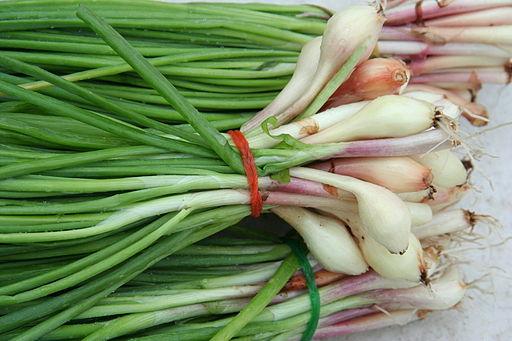 Drying your spices is an absolute must regardless of which spice you are working with. Seed spices are a breeze to dry and can be put right into a jar for cooking. Root spices like garlic and onion will need to be dehydrated. This is best achieved by slicing them very thinly and using an oven on very low heat or a dehydrator. Once your spices are completely dry, you choose to grind them into a powder.
Drying your spices is an absolute must regardless of which spice you are working with. Seed spices are a breeze to dry and can be put right into a jar for cooking. Root spices like garlic and onion will need to be dehydrated. This is best achieved by slicing them very thinly and using an oven on very low heat or a dehydrator. Once your spices are completely dry, you choose to grind them into a powder.
Grind Your Spices
Grinding your own spices into a powder can be done by hand with a mortar and pestle or more quickly by using a blender. Keep in mind that the spices will very likely leave an odor in your blender, so buying a cheap, old blender from your local thrift shop for spices only is a wise idea. A coffee bean grinder can also work very well for seed spices. Once the spices are ground to your preferred consistency, add them to a clean, airtight jar.
Mixing Your Own Spice and Herb Blends
The most anticipated part of growing and preserving your own seasonings is using them for the first time in cooking. You can take cooking with your own seasonings up a notch by creating your own blends for staple dishes in your home. Here are just a couple of basic mixes you can put together using some of the herbs and spices listed in this article. For spices or herbs listed that you don’t have or cannot grow, visit the bulk section of your local store.
Italian Seasoning Mix
- 4 tablespoons each of oregano, basil and parsley
- 2 tablespoons of garlic powder
- 2 teaspoons each of onion powder, thyme and rosemary
- Pinch of salt, pepper and red pepper flakes
Taco Seasoning Mix
- 2 tablespoons of chili powder
- ½ teaspoon each of garlic and onion powder, red pepper flakes, paprika, cumin and oregano
- Pinch of salt and pepper
Chili Powder Mix
- 2 tablespoons each of garlic powder and cumin
- 1 tablespoon each of paprika, cayenne pepper or chili powder and oregano
- 1 teaspoon each of salt and pepper
For a huge reference list of spice mixes, I recommend you check out this link here.
I’ve made a few of my own spice mixes with homegrown herbs and spices and wholeheartedly recommend you give it a try. Not only is it a nice change of pace from gardening vegetables, but the taste of homegrown seasonings puts grocery store mixes to shame.
What advice would you add? Share your tips in the section below:
Do You Know The Biggest Mistakes Gardeners Make? Read More Here.
 Off The Grid News Better Ideas For Off The Grid Living
Off The Grid News Better Ideas For Off The Grid Living



